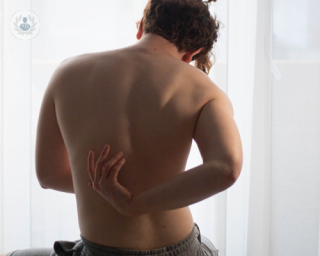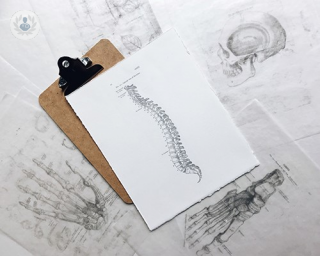Spondylolisthesis
Mr Ramsey Chammaa - Orthopaedic surgery
Created on: 07-23-2015
Updated on: 10-11-2023
Edited by: Sophie Kennedy
What is spondylolistheis?
Spondylolisthesis is a condition affecting the spine where the vertebrae slip out of position, either forwards or backwards. In children, it mostly affects the L5 (5th lumbar vertebra) and the pelvis.
To formulate an accurate diagnosis of spondylolistheis, your doctor will examine your spinal column or will have you raise your leg up, which could cause you some discomfort or pain if you have this condition.

Prognosis
Spondylolisthesis is successfully treated with surgery in 90 per cent of cases. In more rare cases, potential complications such as a compressed nerve or loss of sensitivity to the legs may arise. Conservative treatment is successful in treating roughly 80 per cent of cases.
What are the symptoms?
Depending on how severe it is, spondylolisthesis can also be asymptomatic. The main symptom is a visible worsening of lordosis, that is, a worsening of the normal inward lordotic curvature of the lumbar of the spine.
In its more advanced stages, it could lead to kyphosis, that is, an abnormally excessive convex curvature of the spine in the thoracic and sacral regions. Other symptoms of spondylolisthesis include:
- Pain and numbness in your buttocks and thighs;
- Low back pain;
- Muscular tension and stiffness;
- Increased sensitivity in your legs and in the affected area.
How is it diagnosed?
Spondylolisthesis can be diagnosed with an X-ray scan. Given that it can be asymptomatic, this condition can also be diagnosed collaterally during an X-ray scan done to diagnose another condition.
What causes it?
It can be caused by congenital malformations, by a sudden injury or by acute trauma. Other causes include bone diseases and bone fractures caused by sports such as gymnastics or weight lifting, where the lower back is under a lot of pressure. The most common cause for adults is cartilage damage due to arthritis.
How can it be prevented?
It is not possible to prevent this condition. This is why an early detection is essential to treat it and slow down its progression. However, you can avoid other potential complications by not engaging in sports requiring excessive weight lifting and/or an excessive pressure on you back.
How is it treated?
The treatment depends on how much the vertebra has slipped. In the vast majority of cases, you will have to do some exercises to strengthen your muscles and lower back. A doctor will monitor the progression of the condition with an X-ray scan.
To prevent spondylolisthesis from getting worse, you may have to do one or more of the following:
- Using a back brace to straighten your spine;
- Medication for the pain;
- Physical therapy, focusing on stretching and strengthening exercises;
- Surgery, which will realign the vertebrae.















